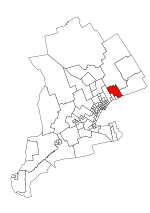Durham (provincial electoral district)

Durham is a provincial electoral district in Ontario, Canada, that has been represented in the Legislative Assembly of Ontario since 1999 and from 1926 to 1975. The Durham provincial riding was created in 1999 when Ontario adopted federal riding boundaries for provincial elections purposes. It was created from Durham East and Oshawa It consisted initially of the Township of Scugog, Scugog Indian Reserve No. 34, the Town of Clarington, and the part of the City of Oshawa lying north of a line drawn from west to east along Taunton Road, south along Ritson Road North, east along Rossland Road East, south along Harmony Road North, and east along King Street East. In 2007, the riding gained the Township of Uxbridge but lost all of its territory in Oshawa with the exception of the areas north of Taunton Road.
Excerpt from the Wikipedia article Durham (provincial electoral district) (License: CC BY-SA 3.0, Authors, Images).Durham (provincial electoral district)
Regional Road 19, Scugog
Geographical coordinates (GPS) Address Nearby Places Show on map
Geographical coordinates (GPS)
| Latitude | Longitude |
|---|---|
| N 44.065 ° | E -78.881 ° |
Address
Regional Road 19 2452
Scugog
Ontario, Canada
Open on Google Maps



